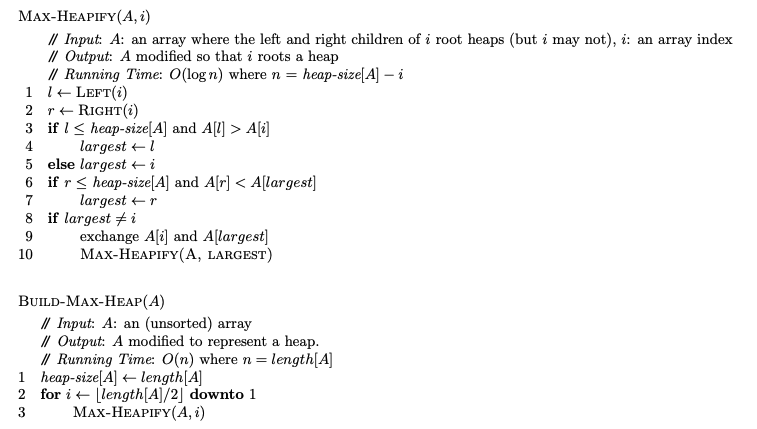Heaps & Queues
Heaps & queues are data structures whose characteristics lend themselves to efficient solutions of certain problems. E.g. heaps allow logn insertion & deletion of elements in order. This can allow its user to avoid searching a list n times & allow an nlogn solution instead of an n^2 one.
Heapify
How can a size N tree, usually passed in as an array, be rearranged in O(n) so that its nodes all satisfy the heap property, i.e. every node in the tree has a value >= (max heap) or <= (min heap) than its children.
Algorithm

Python Implementation
def maxHeapify(A, i):
left = 2 * i + 1
right = 2 * i + 2
largest = i
if left < len(A) and A[left] > A[largest]:
largest = left
if right < len(A) and A[right] > A[largest]:
largest = right
if largest != i:
A[i], A[largest] = A[largest], A[i]
A = maxHeapify(A, largest)
return A
def buildMaxHeap(A):
for i in range(len(A) // 2, -1, -1):
A = maxHeapify(A, i)
return AComplexity
The cost of a call to maxHeapify is O(h), a node may have to swap from its height, h times, to a leaf. The last level on a binary tree has at most n/2 nodes & makes 0 calls to maxHeapify, the next level has n/2^2 nodes & makes at most n/2^2 calls to max heapify. As we approach the height of the root node, h increases. If we sum over the calls to # of maxHeapify calls * O(h) of each call, we have the following:

Last Stone Weight
Given an array of integers representing the weights of stones, smash the two heaviest stones together repeatedly until one or no stones remain. If a stone is heavier it survives the smashing with a new weight less the weight of the lighter stone. Stones equal in weight are both destroyed when smashed together.
Explore
- Use a heap (logk insert/retrieve) to store the stone weights.
- Keep popping the heaviest two stones & smashing them, inserting any left over stone.
- When 1 or no stones remain, return the weight of them. Note: Using a second heap could speed things up in practice but not in theory.
Python Solution
from heapq import heappush, heappop, heapify
class Solution:
def last_stone_weight(self, S) -> int:
N = len(S)
# heapify in place is O(n) < N insertions
# python heap implementation is a min heap -> use negatives
for i in range(N):
S[i] = -S[i]
heapify(S)
while len(S) > 1:
a = -heappop(S)
b = -heappop(S)
if a != b:
heappush(S, -(max(a, b) - min(a, b)))
if len(S) == 0:
return 0
return -S[0]Complexity
We construct a size N heapq in place, Heapify, in N time & pop its top two items repeatedly in constant time, pushing at most one item back into the heap each time for a max n-1 iterations. Each insertion into the heap is logn, therefore, we have an O(nlogn) time & O(n) space solution.